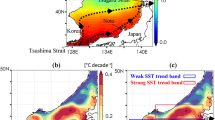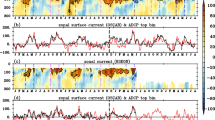Abstract
Seasonal evolution of surface mixed layer in the Northern Arabian Sea (NAS) between 17° N–20.5° N and 59° E-69° E was observed by using Argo float daily data for about 9 months, from April 2002 through December 2002. Results showed that during April - May mixed layer shoaled due to light winds, clear sky and intense solar insolation. Sea surface temperature (SST) rose by 2.3 °C and ocean gained an average of 99.8 Wm−2. Mixed layer reached maximum depth of about 71 m during June - September owing to strong winds and cloudy skies. Ocean gained abnormally low ∼18 Wm−2 and SST dropped by 3.4 °C. During the inter monsoon period, October, mixed layer shoaled and maintained a depth of 20 to 30 m. November - December was accompanied by moderate winds, dropping of SST by 1.5 °C and ocean lost an average of 52.5 Wm−2. Mixed layer deepened gradually reaching a maximum of 62 m in December. Analysis of surface fluxes and winds suggested that winds and fluxes are the dominating factors causing deepening of mixed layer during summer and winter monsoon periods respectively. Relatively high correlation between MLD, net heat flux and wind speed revealed that short term variability of MLD coincided well with short term variability of surface forcing.
Similar content being viewed by others
References
Argo Science Team. 2001. The Global Array of Profiling Floats. p. 248–258. In:Observing Oceans in the 21 st Century, ed. by C. Z. Koblinsky and N. R. Smith, Godae Proj. Off., Bur. Meteorol., Melbourne, Australia.
Bingham, F.M. and T. Suga. 2006. Distributions of mixed layer properties in the North Pacific water mass formation areas: Comparison of Argo floats and World Ocean Atlas 2001.Ocean Sci.,2, 61–70.
Chen, D., L.M. Rothstein, and A.J. Busalacchi. 1994b. A hybrid vertical mixing scheme and its application to tropical ocean models,J. Phys. Oceanog.,24, 2156–2179.
Chowdary, J.S., C. Gnanaseelan, S.K. Sinha, and B. Thompson. 2005. A study on the variability of atmospheric and oceanic process over Arabian Sea during contrasting monsoons.Meteorol. Atmos. Phys.,94, 65–85.
de Boyer Montégut, C., J. Mignot, A. Lazar, and S. Cravatte. 2007. Control of salinity on the mixed layer depth in the world ocean: 1. General description.J. Geophys. Res.,112, C06011, doi:10.1029/2006JC003953.
Godfrey, J.S. and A. Schiller. 1997. Tests of mixed-layer schemes and surface boundary conditions in an Ocean General Circulation Model, using the IMET flux data set.CSIRO Marine Lab. Report (231), Australia.
Kako, S. and M. Kubota. 2007. Variability of mixed layer depth in Kuroshio/Oyashio Extension region: 2005–2006.Geophys. Res. Lett.,34, L11612, doi:10.1029/2007GL030362.
Kara, A.B., P.A. Rochford, and H.E. Hurlburt. 2000. An optimal definition for ocean mixed layer depth.J. Geophys. Res.,105 (C7), 16803–16821.
Kistler, R., E. Kalnay, W. Collins, S. Saha, G. White, J. Woolen, M. Chelliah, W. Ebisuzaki, M. Kanamitsu, V. Kousky, H. van den Dool, R. Jenne, and M. Fiorino. 2001. The NCEP-NCAR 50-year reanalysis: Monthly mean CD-ROM and documentation.Bull. Amer. Meteor. Soc.,82, 247–268.
Millero, F.J., C.T. Chen, A. Bradshaw, and K. Schleicher. 1980. A new high pressure equation of state for seawater.Deep-Sea Res.,27, 255–264.
Montery, G. and S. Levitus. 1997. Seasonal variability of mixed layer depth of the world ocean. NOAA Atlas, NESDIS 14, Washington D.C.
Ohno, Y., T. Kobayashi, N. Iwasaka and T. Suga. 2004. The mixed layer depth in the North Pacific as detected by the Argo floats.Geophys. Res. Lett., L11306, doi:10.1029/ 2004GL019576.
Prasad, T.G. and N. Bahulayan. 1996. Mixed layer depth and thermocline climatology of the Arabian Sea and western equatorial Indian Ocean.Indian J. Mar. Sci.,25, 189–194.
Price, J., R. Weller, and R. Pinkel. 1986. Diurnal cycling: Observations and models of upper ocean response to diurnal heating, cooling and wind mixing.J. Geophys. Res.,91, 8411–8427.
Ravichandran, M., P.N. Vinaychandran, S. Joseph, and K. Radhakrishnan. 2004. Results from the first Argo float deployed by India.Curr. Sci.,86, 651–659.
Suga, T. and K. Hanawa. 1990. The mixed layer climatology in the north-western part of North Pacific subtropical gyre and the formation area of Subtropical Mode Water.J. Mar. Res.,48, 543–566.
Udaya Bhaskar, T.V.S., D. Swain, and M. Ravichandran. 2006. Inferring mixed-layer depth variability from Argo observations in the Western Indian Ocean.J. Mar. Res.,64, 393–406.
Weller, R. A., A. S. Fischer, D. L. Rudnick, C. C. Eriksen, T.D. Dickey, J. Marra, C. Fox, and R. Leben. 2002. Moored observations of upper-ocean response to the monsoons in the Arabian Sea during 1992–1995.Deep-Sea Res. II,49, 2195–2230.
Wong, A., R. Keeley, T. Carval, and the Argo Data Management Team. 2006. Argo quality control manual, ver. 2.2,Report, 33 p., Argo data management, 24th November 2006.
Author information
Authors and Affiliations
Corresponding author
Rights and permissions
About this article
Cite this article
Bhaskar, T.V.S.U., Swain, D. & Ravichandran, M. Mixed layer variability in Northern Arabian Sea as detected by an Argo float. Ocean Sci. J. 42, 241–246 (2007). https://doi.org/10.1007/BF03020915
Received:
Revised:
Accepted:
Issue Date:
DOI: https://doi.org/10.1007/BF03020915




